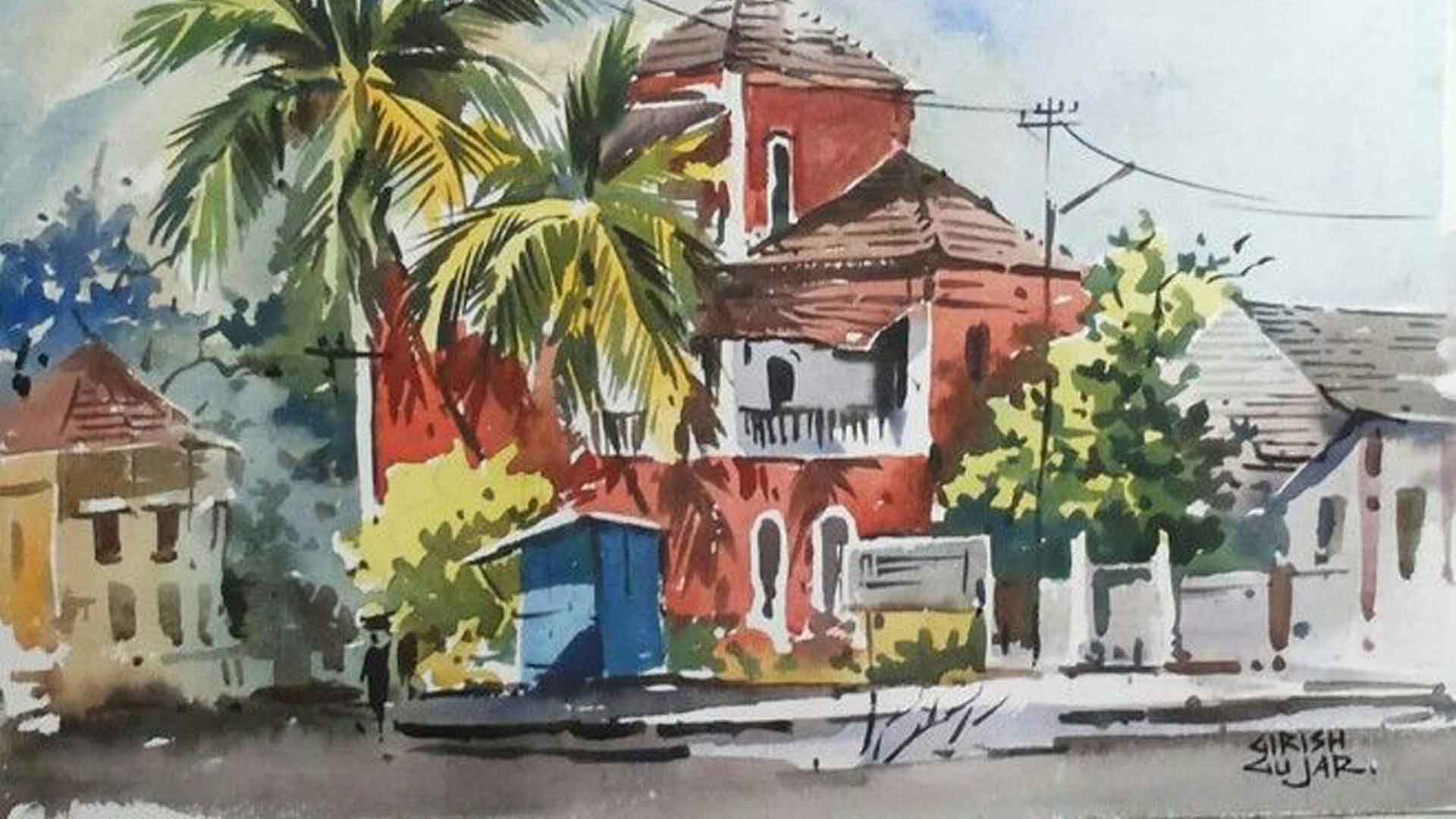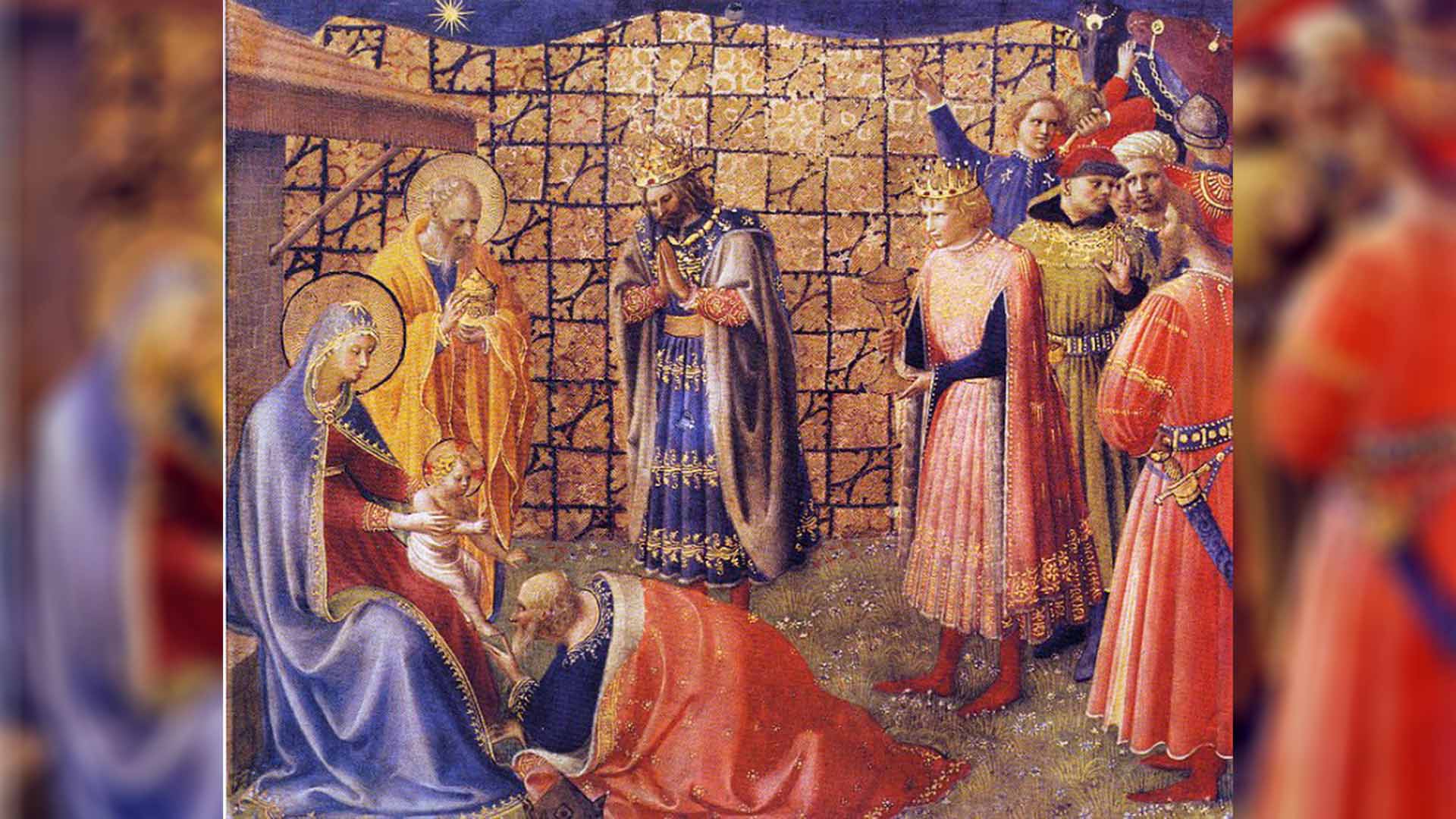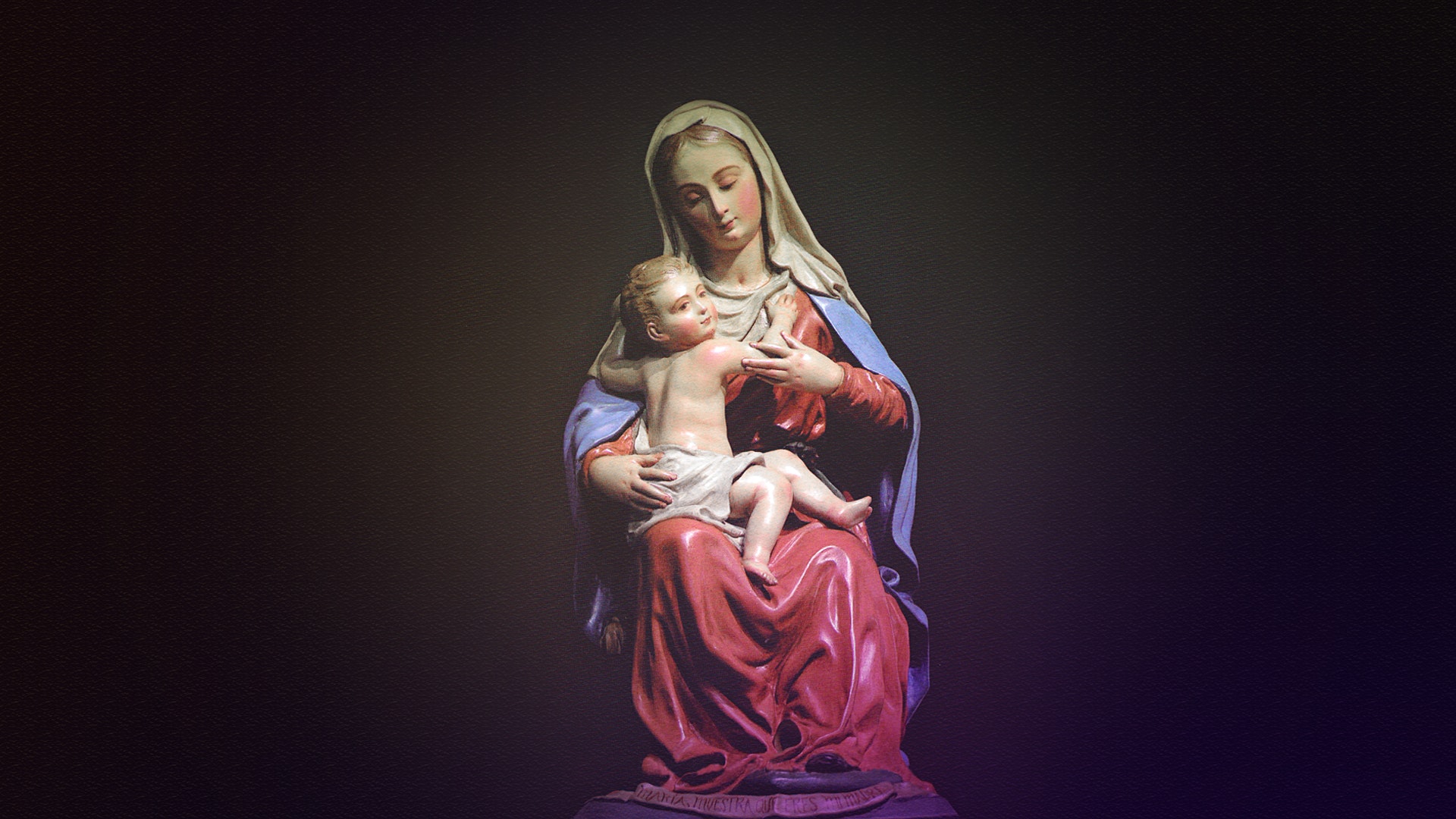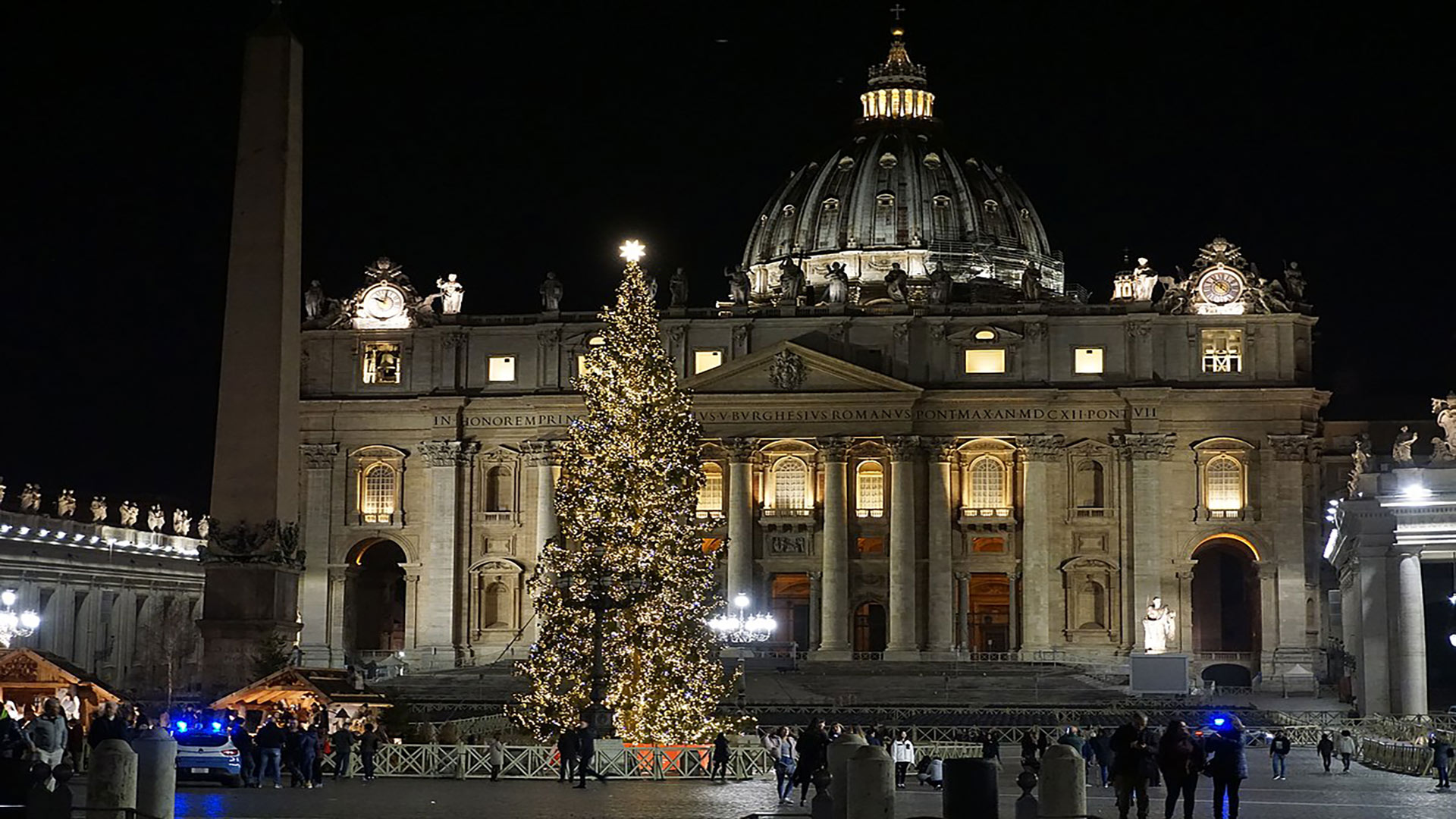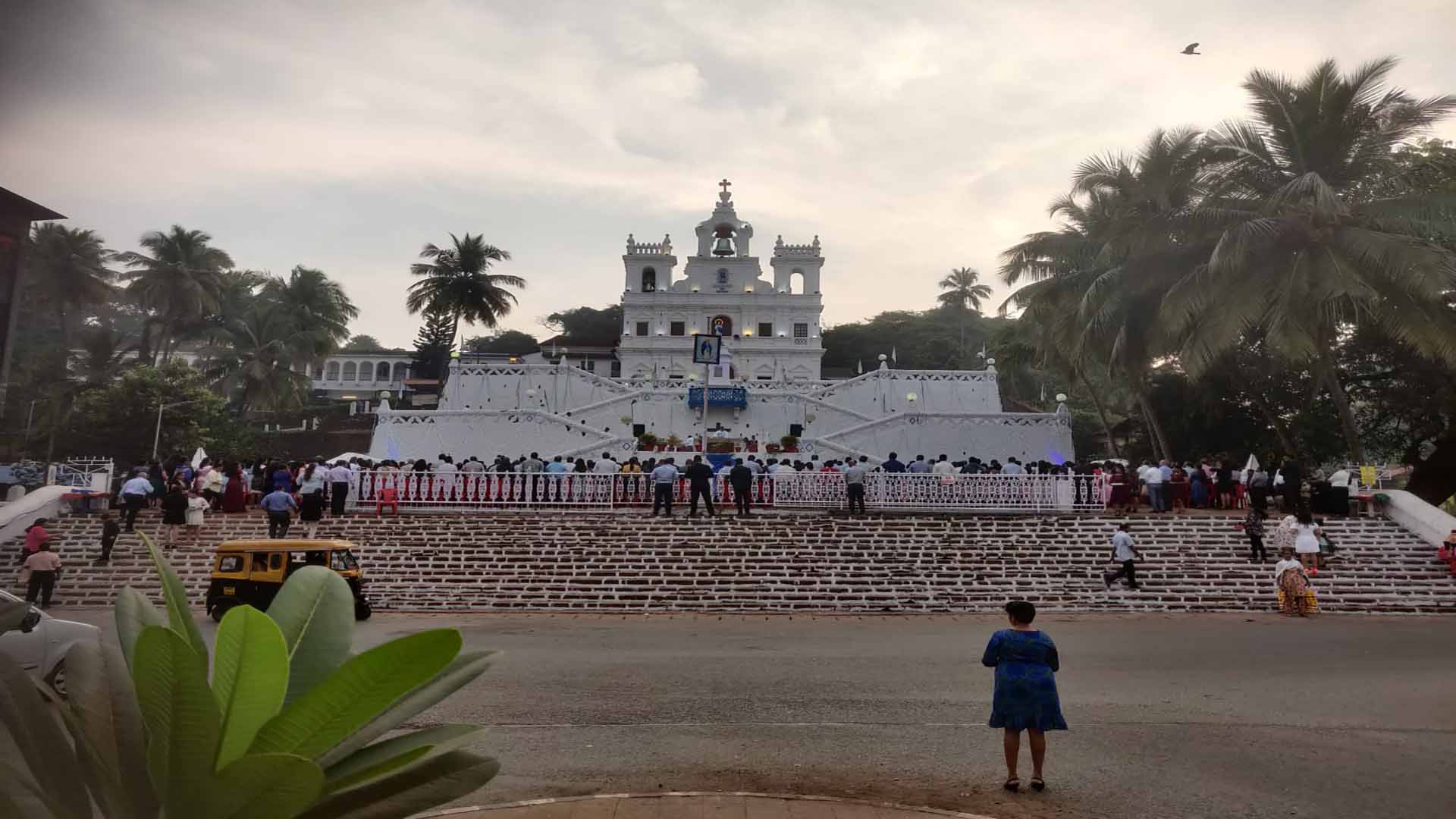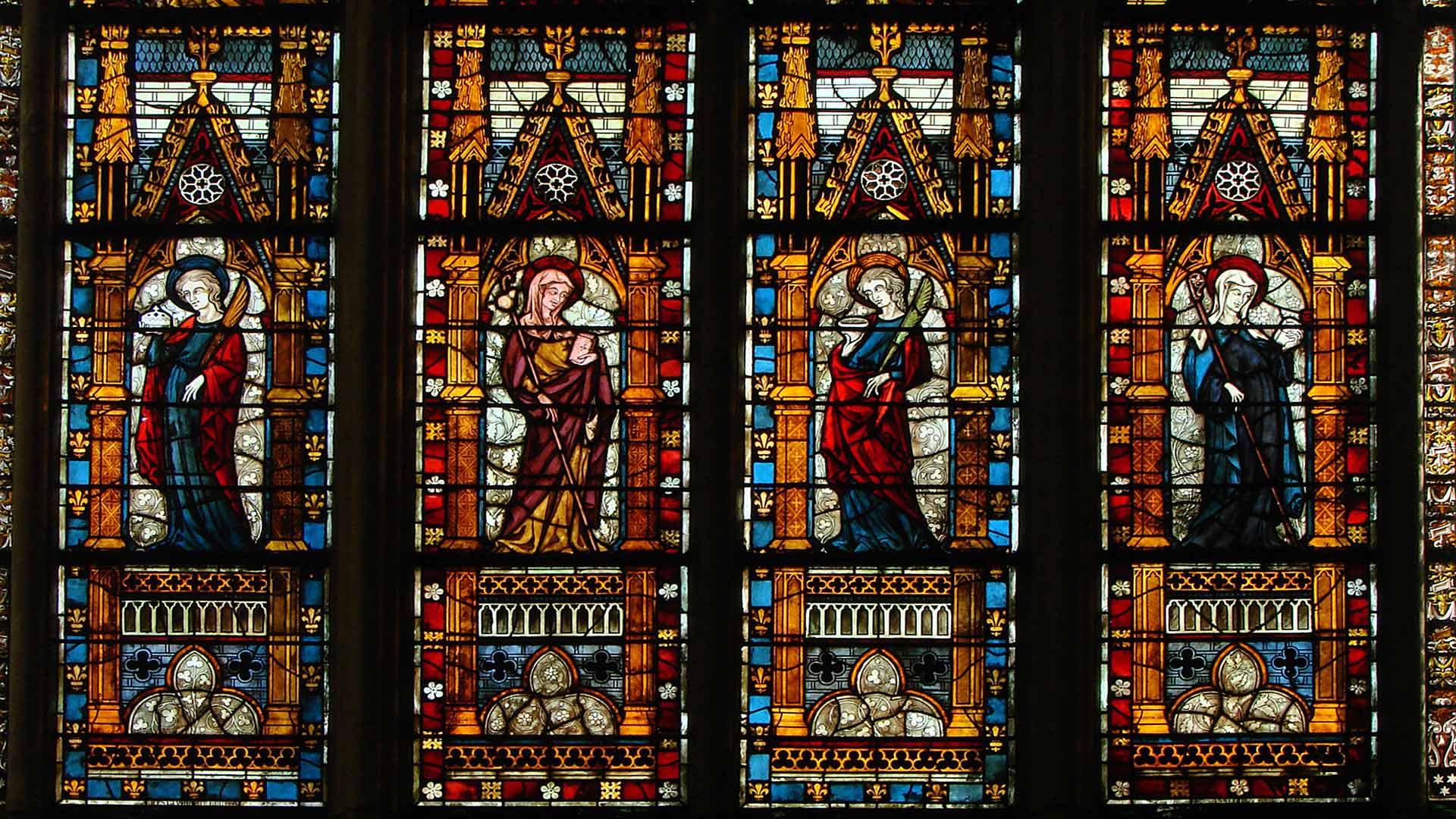Choques e Surpresas Culturais | Culture Shocks and Surprises
Editorial*
Enquanto vos saudamos pelo Ano Novo, também vos agradecemos o apoio à Revista da Casa de Goa, que traz novidades, também na presente edição!
Neste número é inaugurada uma secção de Arte, com a colaboração de três residentes de Goa, os primeiros dois oriundos da União Indiana: Payal Kakkar, artista fotográfica, que explora temas desde o património arquitetónico até a paisagem e conservação do meio ambiente; Girish Gujar, aguarelista e professor de arte; e Clarice Vaz, que ora passa a ser nossa colaboradora residente. A todos três, as nossas boas-vindas!
Ao exímio trabalho desses três artistas que focam o legado artístico de Goa juntam-se, sem ter sido este o intuito, dois dos nossos colaboradores regulares, Francisco da Purificação Monteiro, que disserta sobre as igrejas de Diu, as quais apelida de “património esquecido, em grande estado de degradação”; e Mário Viegas, que se refere à casa de um dos mais célebres Deputados às Cortes Portuguesas, Francisco Luís Gomes: “um imóvel quase abandonado”. São como que as últimas novidades da cultura luso-indiana.
Esse estado de coisas leva-nos a questionar a política cultural dos dois países, a Índia e Portugal. Deixemos por ora a gerência interna e falemos do intercâmbio: teriam sido sinceros os Acordos assinados pelas duas partes? Continua a haver a necessária vontade política na execução das multifárias convenções? Porque tanta assincronia a causar choques culturais? É claro que urge repensar as iniciativas oficiais, sendo ainda mais importante atentar ao nosso modo de pensar, e, em particular, aos princípios e opiniões dos nossos intelectuais ou académicos sobre o assunto em apreço.
Nesse sentido, é imprescindível a leitura do ensaio intitulado “Será a cultura GEM vítima de disparate académico?” Philomena e Gilbert Lawrence analisam discursos académicos rivais em relação à cultura colonial de Goa, East India e Mangalore (daí o acrônimo GEM), territórios outrora sob a égide de Portugal. Apontam para autores lusocêntricos, “que glorificam o imperialismo colonial e exageram o impacto colonial positivo no ethos dos nativos”; os indocêntricos, que “demonizaram o imperialismo colonial e exageraram seu impacto negativo nas práticas culturais dos nativos”; e os goanocêntricos, que “têm uma visão mais amena da colonização e descrevem os colonizadores como “benfeitores e pragmáticos”.
Num mundo globalizado em que não é estranho nutrir uma perspectiva mesclada, o livro intitulado Um estranho em Goa, do escritor angolano José Eduardo Agualusa, é objecto de um ensaio de Júlia Serra, que se surpreende com “esse registo cruzado de elementos, provenientes de culturas e histórias diferentes”; e fala de Goa na lusofonia, a qual continua “em reconstrução de uma identidade”, num caminho sem fim.
Temos ainda o ensejo de apreciar mais um ponto de vista sobre a relação luso-goesa, na crónica “Uma passagem por Portugal”, de Radharao Gracias, que, na sua primeira visita ao país nota paralelos com Goa e enaltece as qualidades dos dois povos que mutuamente se enriqueceram. Enquanto Gracias canta um hino ao Pastel de Nata, será que, para sobremesa, também vos ofereço “A Noiva”, um conto em concani, de Olivinho Gomes, em tradução de Óscar de Noronha? Mas, cautela, ficou comigo “a imagem triste dessa eterna noiva que nos tempos que já lá vão foi tão bela: ela destroça-me o coração e me persegue eternamente”.
Se, por um lado, visitantes goeses encantam-se com Portugal, por outro, duas crónicas nesta edição indicam como os emigrantes goeses se comovem quando de visita a Goa. Armand Rodrigues, que do longínquo Canadá visitou a terra dos seus antepassados, descreve um resort único em Goa, o qual tem à testa “um goês que se mudou conscientemente do seu lar adoptivo em Vancouver para a casa ancestral de sua família, transformando-a em um jardim do Éden em miniatura”. Queiram conhecer esse local idílico em Loutulim, aldeia no sul de Goa; e depois, “vagueando pelas terras do Norte”, na companhia de Mário Viegas, conheçam, entre outros locais, Arambol, uma das praias do hipismo, e o histórico Forte de Tiracol.
Na “Rota aérea para o Paraíso”, desfrutamos de uma vista panorâmica de Goa dos anos sessenta: através dos olhos de Ralph de Sousa, testemunhamos o boom do turismo, a chegada dos hippies e de voos fretados vindos da Europa directamente para o aeroporto de Dabolim, no concelho de Mormugão, o qual, diga-se de passagem, com a vinda do novo aeroporto em Mopa, no concelho de Perném, está a viver os seus últimos dias.
Na secção de entrevistas, Ruta Vedpathak Borkar conversa com cinco goeses que estudaram na Universidade de Puna, dantes conhecida como a Oxford do Oriente. E, para terminar, a secção de Notícias fala-nos das actividades do Ekvat, grupo de danças e cantares da Casa de Goa; de um lançamento de livro da autoria de Francisco Xavier Valeriano de Sá, sócio da Casa de Goa; e de “O Clube”, documentário da autoria de Nalini Elvino de Sousa e Pedro Pombo, o qual retrata a vida da diáspora goesa na Tanzânia. Aproveitamos para vos pedir mais informações sobre o que se passa na vossa área de residência ou de trabalho, sobre a temática Goa-Portugal. E continuemos a reflectir sobre os caminhos que poderá vir a percorrer a cultura luso-goesa.
* Texto revisto. Publicado na Revista da Casa de Goa, Serie II, No. 20, Jan-Fev 2023
Editorial*
Let me extend New Year greetings to all you dear readers and thank you wholeheartedly for supporting Revista da Casa de Goa, which comes to you with news and views in yet another edition!
This issue carries an Art section, thanks to the collaboration of three residents of Goa, the first two being settlers here: Payal Kakkar, a photo artist exploring themes ranging from architectural heritage to landscape and environmental conservation; Girish Gujar, watercolourist and art teacher; and Clarice Vaz, who is now a resident contributor. To all three, a hearty welcome!
Unwittingly, these three excellent artists who focus on the artistic legacy of Goa are joined here by two of our regular writers, Francisco da Purificação Monteiro, who writes about the churches of Diu, dubbing them “forgotten heritage, in a great state of degradation”; and Mário Viegas, who refers to the “almost abandoned property” of one of the most famous of the Goan Deputies to the Portuguese Parliament, Francisco Luís Gomes. They are like the latest shocks of Luso-Indian culture.
This state of affairs leads us to wonder about the cultural policy of India and Portugal. Leaving aside their domestic policies for the moment, let us talk about their high-level exchanges: how sincere were they when they signed agreements? Is there still that much-needed political will to implement those varied conventions? Why the asynchrony causing culture shocks? It is imperative to reassess official initiatives, and even more so, pay attention to our rationale, and, in particular, to the principles by which our intellectuals or academics are guided and the opinions they hold on the subject.
In this regard, the essay titled “Is GEM culture a victim of academic baloney?” is vital. Philomena and Gilbert Lawrence analyse rival academic discourses on the colonial culture of Goa, East India and Mangalore (hence the acronym GEM), territories once under the aegis of Portugal. They point to Lusocentric authors, “who glorify colonial imperialism and exaggerate the positive colonial impact on the natives’ ethos; Indocentric authors, who “demonized colonial imperialism and exaggerated its negative impact on the natives’ cultural practices”; and the Goacentric authors, who “have a kinder view of colonization and describe the colonizers as “benefactors and pragmatic”.
In a globalized world where it is not strange to nurture a mixed perspective, the book entitled A Stranger in Goa, by the Angolan writer José Eduardo Agualusa, is the subject of an essay by Júlia Serra. She is surprised by “this cross register of elements, coming from different cultures and histories”; and speaks of Lusophone Goa, now on the endless path of reconstructing its identity.
We also have the opportunity to appreciate another point of view on the Luso-Goan relationship, in “A Passage through Portugal”, by Radharao Gracias. On his very first visit to the country, he notes parallels with Goa and praises the qualities of the two peoples that have mutually enriched each other. While Gracias sings a paean to Pastel de Nata, for dessert may I also offer you “A Noiva”, a short story in Konkani, by Olivinho Gomes, translated into Portuguese by Óscar de Noronha? But, please note, “the sad image of that eternal bride who in times gone by was so beautiful remained with me: she breaks my heart and haunts me eternally”.
If, on the one hand, Goan visitors are enchanted by Portugal, on the other hand, two features in this issue show how Goan emigrants are moved on their visit to Goa. Armand Rodrigues, who from faraway Canada visited the land of his ancestors, describes a unique Goan resort headed by “a Goan who has consciously relocated from his adopted home in Vancouver, back to his ancestral family home, which he has transformed into a miniature garden of Eden.” Please visit this idyllic spot in Loutulim, a village in South Goa; and then, “wandering through the North”, in the company of Mário Viegas, you will get to know, among other places, Arambol, a public bathing beach, and the historic Fort of Tiracol.
In “Skyway to Paradise”, we enjoy a panoramic view of Goa: through the eyes of Ralph de Sousa, we witness “the tourism boom that started in the early sixties, with hippies coming and followed by chartered flights arriving from all over Europe directly to Dabolim airport,” situated in the taluka of Mormugão; which, with the coming of a new airport at Mopa, in Pernem taluka, is now on its last legs.
In our Interview section, Ruta Vedpathak Borkar chats with five Goans who studied at the University of Poona, once known as the “Oxford of the East”. And in the News section we hear about the activities of Ekvat, Casa de Goa’s song and dance group; a book launch by Casa de Goa associate Francisco Xavier Valeriano de Sá; and “O Clube”, a documentary by Nalini Elvino de Sousa and Pedro Pombo, which portrays the life of the Goan diaspora in Tanzania. We take the opportunity to ask you for more information about what is going on in your area of residence or work, focussed on the Goa-Portugal theme. And let us continue to reflect on the paths that Luso-Goan culture could eventually take.
* Revised text. First published in Revista da Casa de Goa, Series II, No. 20, Jan-Feb 2023
Luminous Epiphany
In places where the Solemnity of the Epiphany has been moved from 6 January to the Sunday between 2 and 8 January (both days inclusive), the readings are quite different from those that celebrate it as originally set. Meanwhile, three parishes in the archdiocese of Goa celebrate the feast on the traditional day: the church of Reis Magos (The Magi), in Verem, Tiswadi; the chapel of Our Lady of Remédios (Cures) in Cuelim, Mormugão; and the church of Our Lady of Bethlehem, in Chandor, Salcete; where little boys play the Wise Men who followed a wondrous star to Bethlehem and paid homage to the Infant King.
The Epiphany (from the Greek ‘manifestation’) is an ancient feast that predates the celebration of Christmas on 25 December. It was central to Christian life: whereas Jesus was born unsung, His manifestation to the Magi illuminated the mystery of Christmas. The early Church combined that Visitation with the Nativity, the Baptism of Christ in the Jordan, and the Wedding at Cana, all of which pointed to Jesus as the Son of God. Only centuries later, at the Council of Tours in 567, the Church set Christmas day on 25 December, the Epiphany on 6 January,[1] and named the twelve days between the two feasts as the Christmastide, with the latter solemnity marking the grand finale.
The day’s readings highlight an incomparably sublime event in the history of humankind: the manifestation of Jesus Christ. As the First Reading (Is 60: 1-6) looks at battered Jerusalem, he envisions it as the quintessential city that will be the Bride of the Lord. The city would manifest its glory, and the peoples of the world would flock to it with gifts, the same as the Magi would bring to the Babe of Bethlehem centuries later. Most importantly, by the end of times, “all nations shall fall prostrate before you, O Lord,” as the Psalm says.
While the Gospel (Mt 2: 1-12) echoes Isaiah’s prophecy, it also quotes the chief priests and scribes as saying to king Herod that it was indeed written by the prophet (Micah 5: 1-2; 2 Sam 5: 2): “And you, O Bethlehem, in the land of Judah, are by no means least among the rulers of Judah; for from you shall come a ruler who will govern my people Israel.” On the one hand, it shows how well the authorities knew about the coming of a Messiah, but, sadly, they would reject Him. On the other hand, the reference to Bethlehem is significant, for Jesus would give up on the fortress Jerusalem and choose to be born in humble Bethlehem.
Herod’s wily ways should be noted: was he not all sweetness who bade the Magi to let him know where the Babe lay, and almost in the same breath ordered the killing of infants under the age of two? A great lesson for us who are naïve vis-à-vis the world and its devious ways. Although we enjoy the benefits of Christian civilisation, we fail to notice infiltrators bent on paganising the Mystical Body of Christ. Are Christians sufficiently alert and zealous to stand up and speak up? Are we sufficiently imbued with the Good News to desist from entertaining bad news?
We must emulate the Magi of yore and reject the world's Herods. Those noble pilgrims from the Orient, astrologers and/or philosophers conversant with Hebraic messianic beliefs, were the first Gentiles to adore Jesus; they accepted Him while the authorities rejected Him, a pathetic drama that is still unfolding in our times. The gifts they offered were gold, in acknowledgement of the royalty of Jesus; frankincense, a reference to His divinity; and myrrh (not mentioned by Isaiah), pointing to Jesus's suffering humanity.
St Paul in the Second Reading (Eph 3: 2-3, 5-6) states that the Gentiles are indeed “fellow heirs, members of the same body, and partakers of the promise in Christ Jesus through the Gospel.” This is in stark contrast to the narrow and exclusive Jewish idea of Salvation. The Chosen Race had clearly failed God, so the Church is now the chosen race, royal priesthood, and holy nation. It makes you and I privileged to be bearers and proclaimers of His luminous message. Our task is to put the lamp on a stand, such that it gives light to all in the house! Instaurare omnia in Christo.
Banner: http://www.catholicstpeter.com/Epiphany/slides/adoration__of__the_magi-_fra_angelico.html
[1] The Church has spread out the rest of the feasts.
Under Two Holy Names
The New Year will be brought in with much fanfare the world over. The faithful will drive enthusiastically to church in their best outfits to pray for a worthy year ahead. Although it is the beginning of a civil year, we ought to honour it because Time belongs to God.
There is also a Christian facet to it. It is the Octave of Christmas and the first day of the Gregorian calendar as introduced by Pope Gregory XIII in 1582, replacing the Julian calendar whose algorithm had miscalculated the date of Easter.
Although the Gregorian calendar is now used in most parts of the world, some churches not affiliated with Rome still follow the Julian calendar. Ukraine is an example. A few years ago, in a bid to distance itself from the Russian Orthodox Church, Zelenksky’s country fell in line with the Church in the West and began celebrating Christmas on 25 December, instead of 6 January.
The first day of the civil year is also dedicated to the Blessed Virgin Mary in celebration of her unique privilege and title as Mother of God. Accordingly, the readings dwell on the Mother of Jesus and on the Holy Name of Jesus.[1] The Feast highlights Mary's role in the economy of Salvation and helps us place our problems and concerns under her mantle.
The Catholic Church also celebrates the World Day of Peace[2] on the first day of the first month of the year.
In today's First Reading (Num 6: 22-27) one of the five books (Pentateuch) dictated by God to Moses. Called so because it begins by listing the numbers of a census of the Hebrew people, the Book represents a march of God’s people across the desert wilderness between Egypt and Canaan. During this march, the participants gathered experiences that eventually impacted their future. God asked Moses to request Aaron, a fluent speaker, to address the Pharaoh.
Aaron, along with Moses, delivered God's message to Pharaoh: 'Let my people go, so they hold a festival for me in the wilderness'. When Pharaoh refused, demanding to know who the Lord was, Aaron performed miracles (turning his staff into a snake) to show God's power, but Pharaoh remained stubborn, increasing the Israelites' burdens.
The blessing is a general priestly blessing for the wellbeing of Israel. It is often seen as being fulfilled in the Birth of Jesus. The mystery of the Incarnation was a fulfilment of a long wait; it was a manifestation of God’s benevolence and love for humankind, His supreme creation. His Son liberated us from the old law and from sin; we have also secured His blessings, the privilege to be called God’s children (rather than creatures) being the highest one for Christians.
Of course, none of this would be possible without the willing collaboration of the Blessed Virgin Mary. She is thus, very naturally, the Mother of God and Mother of the Church, which is the Body of Christ on earth.
This is why St Paul in the Second Reading (Gal 4: 4-7) says: 'God sent forth His Son born of woman, born under the law, to redeem those under the law, so that we might receive adoption as sons.' His words highlight the human side of the Son of God, that He became man to first save the Chosen People, that He was formed by the religion of his ancestors (to us, the Old Testament), and that in time He perfected the law, whereby all men and women of goodwill would be saved.
Finally, in the Gospel (Lk 2: 16-21), the poor shepherds were the first to receive the Good News of Salvation. They met Mary and Joseph, with the Divine Babe lying in a manger. They soon understood the magnificent Hymn of the Angels, Gloria in excelsis Deo et in terra pax hominibus bonae voluntatis, and became the first proclaimers of the Word made Flesh. They were adopted as children of God.
The fact that, at the end of the Octave, Jesus was circumcised and given His Holy Name, as preannounced by the Angel Gabriel to Mary, justifies the celebration of His Holy Name together with Mary’s title as Mother of God. It also explains why 1 January was observed as the Feast of the Circumcision of Jesus, with a Marian orientation predating it, since the 13th century. However, this feast day was cancelled by Pope John XXIII’s General Roman Calendar of 1960 and simply called the Octave of the Nativity.
Like Mary, we too need to treasure all these things, ponder them in our hearts, and be ever more faithful to Holy Scripture and Tradition. The Blessed Virgin, who had a unique understanding of Jesus's divinity and mission from the beginning, understood the full import of her Son’s words after the Resurrection and Pentecost.
We too ought to bide our time and put His Holy Name upon our world, pray for God’s blessing, and discern our vocation. Above all, by God’s grace, we ought to eschew sin, cease to be slaves of the world, and happily be sons and heirs. The affirmation of their Christian past and inheritance by European and American leaders signals a new grace that is entering our hedonistic world.
Banner: https://daylesford.org/the-solemnity-of-mary/
---
[1] The feast of the Maternity of the Blessed Virgin Mary was first granted to the dioceses of Portugal and Brazil and Algeria in 1751 on the petition of King José I of Portugal. By 1914, the feast was established in Portugal for celebration on 11 October and was extended to the entire Catholic Church by Pope Pius XI in 1931. The 1969 revision of the liturgical year changed it to 1 January.
[2] Pope Paul VI established it in 1967, inspired by Pope John XXIII’s Encyclical Pacem in Terris (1963) and with reference to his own Populorum Progressio (1967).
The Three Christmas Masses
December 25, 2022Mass Readings
Did you know of the three Christmas Masses – Midnight; Dawn; Morning – each with its own liturgy?
The Midnight Mass is also called ‘the Angel's Mass’; the second, ‘the Shepherd's Mass’; and the third, ‘King's Mass’.
Although all readings are on the theme of hope, light, and salvation, each of the three Masses has its own focus and all of them are worth reflecting upon.
The First Reading is always from the Book of Isaiah, who is the Prophet par excellence of the Messiah and the Good News. The Second Reading of the first two Masses comprise passages from St Paul’s Letter to Titus whereas the Morning Mass is taken from the Letter to the Hebrews. The Gospel of the first two Masses is from St Luke, while the daytime Mass reads from St John.
The Lectionary carries a note: 'For pastoral reasons, one or other of the three Masses may be used at any hour.'
MIDNIGHT MASS
Why a Mass at midnight? It is traditionally believed that Jesus was born at midnight. The physical darkness is a reminder of the spiritual darkness we are steeped in, a darkness that only Christ the Light of the World can dispel.
The First Reading (Is 9: 2-4, 6-7) states: 'The people who walked in darkness have seen a great light.' The prophecy is specific to Israel, whose king, Ahaz, had entered into alliances with kings instead of with the King of Kings. Isaiah announced to the hapless nation that the royal line would produce a descendant that would save them. Ahaz’s son Ezekiah was indeed a righteous king, but the adjectives describing him – 'Wonderful Counsellor, Mighty God, Everlasting Father, Prince of Peace' – are infinitely more apt for Jesus Christ the Messiah, a descendant of the Royal House of David.
The Gospel account (Lk 2: 1-14) is about the humble birth of Our Lord, proof enough that His government would be of the spiritual realm. That 'there was no place for them in the inn' tells us of how the rich and mighty would reject Him, as they still do. It is no wonder that the poor shepherds were the first to be invited to visit the Divine Babe in Bethlehem.
After the Fall, there was a chasm between God and man. The Son of God came to overcome that barrier, yet we vacillate when it comes to things divine. Nowadays, when in the name of secularism, the world is steeped in irreligion and passions, let us heed St Paul’s advice to Titus (2: 11-14): '… live sober, upright and godly lives in this world, awaiting our blessed hope, the appearing of the glory of our great God and Saviour Jesus Christ.'
In this dark world, then, Christmas comes with a message of light and hope for humankind.
DAWN MASS
The Mass at dawn commemorates the shepherds’ early and eager visit to adore the Lord in the manger. As natural light increases at dawn, those who believe in the Lord are blessed with His gift of light.
In the First Reading (Is 62: 11-12), Isaiah announces the good news of salvation to the daughter of Zion, that is, Jerusalem, or the Jewish people. As the luminous Psalm says, 'This day a new light will shine upon the earth: the Lord is born to us.' This light will shine on the just, and joy will belong to the upright of heart.
The Gospel (Lk 2: 15-20) tells us that the lowly – represented here by the shepherds, who were considered the scum of the earth – are the upright of heart: they see with eyes of faith, and they glorify and praise God. Like little children, it is the lowly who are apt to inherit the kingdom of God.
Yet, we are never worthy. As St Paul says to Titus (3: 4-7): 'When the goodness and loving kindness of God our Saviour appeared, He saved us, not because of deeds done by us in righteousness, but in virtue of his own mercy.' Our baptism, then, is the dawn of a new life of the spirit.
DAY MASS
The third and final Christmas Mass is celebrated in broad daylight, symbolising the promised Son of God Who has been revealed to the world. The Gospel reading is a standing invitation to all nations to worship the new-born King of Kings, hence the name ‘King's Mass’.
The First Reading (Is 52: 7-10) announces the Good News to Israel, and eventually, to 'all the nations; and all the ends of the earth shall see the salvation of the world.' How happy we should consider ourselves to be included in that number, thanks to the Apostles who visited our subcontinent way back in the first century (Kerala, Tamil Nadu) and later, other proclaimers of the Word, from the 16th century onwards (Goa and surrounding areas).
The Gospel (Jn 1: 1-18) strikes a somber note, that is, nevertheless, thought-provoking: 'The true light that enlightens every man was coming into the world, He was in the world, and the world was made through Him, yet the world knew him not.'
How true that is of our world two millennia after the Birth of Jesus. We know Him not, and those who are privileged to know, care not! 'He came to his own home, and His own received Him not.' Jesus came to save Israel, and they rejected Him; He wants us to announce the Good News to the world, and what do we do?
How can we despise God Who has stretched out His hand to humankind?
The Second Reading (Heb 1: 1-6) emphasizes how 'in many and various ways God spoke of old to our fathers by the prophets; but in these last days He has spoken to us by a Son… He reflects the glory of God and bears the very stamp of his nature, upholding the universe by his Word of power.' Let us acknowledge Him duly and gratefully.
RESOLUTION
This Christmas let us reflect on the power and glory of God and how we are privileged to inherit His light on earth and everlasting life in Heaven. Let us rise above matter and embrace the spirit; let us look beyond the physical and gaze at the supernatural; let us put the pettiness of the world behind us and live like angels on high.
Thanks to the Holy Catholic Church, the ineffable mystery of Christmas stays with us through the year.
Awaiting that Wondrous Birth
December 18, 2022Mass Readings
"Behold, a young woman shall conceive and bear a son, and shall call his name Immanuel."
We find those reassuring words in the First Reading (Is 7: 10-14). Isaiah said these things to king Ahaz, a young and evil king of Judah (731 BC to 715 BC) responsible for introducing idol worship and sacrilege against the temple of the Lord (2 Kings 16; 2 Chron 28). The Prophet wanted to win Ahaz back to the Lord by announcing the coming of a son named Ezekiah, who would save Israel. However, Ahaz despaired of God’s help and, putting his trust in kingly alliances, caused the kingdom’s decline and destruction.
Ahaz’s son Ezekiah became one of Judah’s most blessed kings. He reversed his father’s ungodly policies and restored the kingdom. He is seen as an initial fulfilment of the coming of the Messiah, Jesus. Isaiah’s words prefigured Jesus Christ, marking the beginning of messianism.
Can there be a clearer sign that Jesus was the One referred to in those words of the Prophet Isaiah? Some versions even translate ‘young woman’ as ‘virgin’. Who other than Jesus can claim virgin birth? What woman other than Mary ever gave birth as a virgin? Was it not clear that this was the Messiah that Israel had long been awaiting?
However, how many Ahazes in our midst and, sadly so, within the Church itself, have facilitated the entry of the “smoke of Satan” through a crack, as a Pope pointed out in the 1960s!
For our part, we have to “let the Lord enter! He is the king of glory,” the Psalm sings. St Paul in the Second Reading (Rom 1: 1-7) says that we are “called to belong to Jesus Christ.” This is an unparalleled privilege and supreme honour, yet how reluctantly we wear the badge! In some countries, atheism reigns; in others, indifferentism (the belief that God is indifferent to religious differences) rules the roost. Soon, such attitudes led to the renouncing of religious symbols in Catholic institutions in the name of "political correctness". It is another way of saying "God is dead".
Even in this blessed season of Advent, we find ourselves so engrossed in worldly things that we forego the birth of our Savior! It is disastrous that at Christmas, held with pomp and splendour, Christ is only a pretext for a mundane celebration. Should not the Scripture readings of this liturgical season and the Gospel (Mt 1: 18-24) of today, which dwells on the wondrous Birth of Our Lord, have moved our hearts?
In the context of Jesus’ birth, Mary had already been betrothed to Joseph when she received the divine call to be the Mother of Jesus. In those days, betrothal meant that the pair were husband and wife in all legal and religious aspects, except for actual cohabitation. So, even before they came together, Mary was with child through God’s design.
Thus, Jesus’ birth occurred in accordance with the Isaian prophecy. Yet, it was not without a trace of suspicion; and if we fast-forward to our times, some may be tempted to irreverently think of Mary as an unwed mother. However, it was clearly not so. God, in His infinite wisdom, had provided for Jesus to be born before the couple had come together, to make it clear that He was the “child of the Holy Spirit.” The virgin birth claim would have failed if Jesus had been born after the couple’s cohabitation.
No doubt, Joseph himself had reservations about Mary, who was with child; he even wanted to “quietly send her away.” Eventually, he believed the angel’s words: “Do not fear to take Mary your wife, for that which is conceived in her is of the Holy Spirit; she will bear a son, and you shall call his name Jesus.” This was so unlike King Ahaz, Jesus' ancestor from the House of David, who became a victim of his own scepticism.
Thanks to Joseph the Silent Saint and Mary, who conceived without Original Sin, the world is blessed to have the Son of God become man to save us. For sure, the earth never saw anything more wondrous than the birth of Our Lord and Saviour.
Therefore, as we enter the last leg of our Advent journey, let us focus on our internal rather than external joy of anticipation. Let us, like people with clean hands and a pure heart, who desire not worthless things, await the divine event (cf. Ps. 23: 4), and let us wholeheartedly collaborate with God in His plans of salvation.
Joy beyond compare
December 11, 2022Mass Readings
If celebrating the halfway mark helps boost our spirits, then Gaudete Sunday does just that. Therefore, let us rejoice not only because Christmas is near but also because we have persevered in preparing for the Lord’s coming.
This Sunday draws its name from the Latin Missal’s introit, which reads: “Gaudete in Domino semper,” meaning “Rejoice in the Lord always.” Besides the pink or rose of the candle and of the priestly vestments symbolising joy, the readings, imbued with a supernatural joy, help us bide our time to contemplate the Babe of Bethlehem.
However, can we really rejoice with the enveloping world of war, disease, corruption, climate change, suffering, and unrest? Will it be possible to rejoice only in Messianic times?
In the First Reading (35: 1-6a, 10), Isaiah speaks of the time when nature will rejoice and sing with strength at the coming of the Lord of Creation to save those who had longed for Him and suffered for the sake of His Holy Name.
On the other hand, we can experience joy even though we live in this valley of tears. It is not a superficial joy brought in with festoons, but a supernatural joy that comes with faith. This joy is not a mere sensation but an act of the will—not dependent on what we feel but on what we consciously wish to feel. Truly, Christian joy is guided by our conviction that God moves and controls all history; it is not contingent on the ups and downs of daily life. By His Incarnation, we know that He is there for us and saves us: easily a cause for rejoicing, isn’t it?
In the Second Reading (Jam 5: 7-10), the Apostle[1] addresses Christians of Jewish origin. It is more of a moral teaching than a doctrinal teaching. He preaches patience, akin to that of a farmer awaiting “the precious fruit of the earth,” or a woman expecting a baby. His wise counsel is to “establish your hearts”; to “not grumble against one another”; and to “take the prophets who spoke in the name of the Lord” as role models. Simple yet effective advice. If we conduct ourselves in keeping with our faith and cultivate prudence and resignation, we will soon be on the highroad to holy joy.
Of joy, we have a harbinger in St. John the Baptist, one of the many prophets who spoke in the name of the Lord. In the Gospel (Mt 11: 2-11), Jesus says that John is “more than a prophet. This is he of whom it is written, ‘Behold, I send my messenger before Thy face, who shall prepare Thy way before Thee.’" Yet, the Forerunner of Christ, wanting to be doublesure, demands to know if Jesus is indeed the Messiah that they were waiting for. His humble ministry did not match that of the fiery, conquering Messiah expected by many.
For his part, the Messiah defines his scope of action and directs John’s gaze to how He (Jesus) fulfilled the Isaian prophecy. He had given sight to the blind and let the lame walk; He had cleansed the lepers, cured the deaf, and raised the dead. The poor in spirit acknowledged those wonders; others, finding no place for the Lord, went on from smugness to spiritual blindness and hard-heartedness.
Where do we stand? Do we realise that Jesus is the Messiah as announced by Isaiah and John? Are we poor in spirit? Do we acknowledge our spiritual need for God, like the poor shepherds did as they kept watch over their flocks by night? It is no wonder that they were chosen to be the first to hear the Good News and received it with joy.
Owing to the shepherds’ proverbial joy, the third candle of Advent is called the Shepherd’s Candle. As we light it today, may we receive the grace to be increasingly hopeful and better prepared to meet the Lord. Our joy will be beyond compare.
---
[1] “Brother [cousin] of the Lord” (Gal 1: 19), a man of great reputation but barely mentioned in the Gospel. He began to believe in Jesus only after the Resurrection and a few years after Pentecost was a leader responsible for Christian communities having a majority of Jews in Palestine, Syria and Cilicia (present-day Turkey) (cf. Acts 15: 13-29) Of all the apostles, he was the most attached to Jewish traditions – the extreme opposite of St Paul.
Panjim Church to me
In reply to a quick question from Dolcy D'Cruz of Herald, Panjim, last night... Thank you, Dolcy!
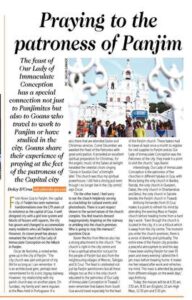
The city church has been part and parcel of my life for as long as I can remember. It is an architectural gem, perhaps best remembered for its iconic zigzag stairway.
However, my relationship with my parish church was on another plane. On Sundays, my family and I were regulars at the Mass held in Portuguese. It is also there that we attended Easter and Christmas services.
Come December, we awaited the Feast of the Patroness with great anticipation. It provided an excellent spiritual preparation for Christmas, for the angelic music of the Salves at twilight heralded the celestial choirs singing "Gloria in Excelsis Deo" a fortnight later. The church was thus my spiritual powerhouse. I still feel a strong pull even though I no longer live in the city centre.
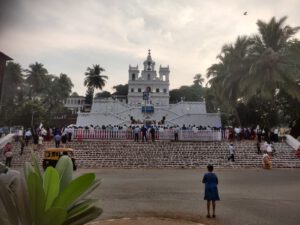
On the other hand, I feel sorry to see the church helplessly serve as a backdrop for cultural events and photoshoots. There is scant respect shown to the sacred nature of the church complex. You find tourists dressed inappropriately, lingering on the stairway or ambling into the church premises. Who is going to stop this menace?
A story of great promise
“You have made us for yourself, O Lord, and our heart is restless until it rests in you,” St Augustine says in his famous Confessions. Thankfully, as we enter the second week of Advent, the Prince of Peace gives us the grace to achieve peace of mind and heart.
When the Lord touches us, life changes for the better. So it was with Jesse, a sheep farmer in Bethlehem, whose youngest son, David, received God’s call to be the king of Israel. David’s reign and that of his son Solomon formed a golden era, but soon after that, Israel began to produce godless kings.
In those dark hours, Isaiah’s prophecy, heard in today’s First Reading (Is 11: 1-10), was heart-warming: “There shall come forth a shoot from the stump of Jesse, and a branch shall grow out of his roots.” That regal shoot would be wise and clever like Solomon, prudent and strong like David; knowledgeable and respectful like Moses and the Patriarchs.
Clearly, Isaiah’s words referred to the Messiah. Born seven centuries later, Jesus was the “root of Jesse” who would provide an ensign to the Gentiles and pagans. The Jews, long awaiting a Messiah, did not acknowledge the Carpenter’s Son; it was their loss and our gain, for now we can hope for the Lord’s Second Coming, when, “Justice shall flourish and peace till the moon fails.” (Ps 71: 7-8) And “justice” (sanctity or victory over sin) will cause peace.
The Gospel of St Matthew (3: 1-12) takes us back to Isaiah, who had pointed to “the voice of one crying in the wilderness: 'Prepare the way of the Lord, make His paths straight’”—unmistakably the future John the Baptist! His message is as relevant today as it was when Jewish high society’s observance of religious precepts was mere tokenism or façadism. They were formalist and materialist, just as the world today is consumerist to boot.
What a far cry from the austere life of the Baptiser. Like the prophets of old, especially Elijah (cf. 2 Kings 1:8), he wore a camel’s hair garment, strapped a leather belt around his waist, and survived on locusts and wild honey. His mission was to serve: by announcing the Good News, baptising[1] the repentant, and denouncing the wicked. He called the bluff of the Pharisees and the Sadducees[2]—that “brood of vipers”—demanding that they “bear fruit that befits repentance” rather than bask in Abraham’s glory.
The promise of salvation continues through the Church. St Paul (Rom 15: 4-9) was convinced that “whatever was written in former days was written for our instruction, that by steadfastness and by the encouragement of the Scriptures we might have hope.” Jesus followed the law even as he sought to perfect it.
Take circumcision. The act, which was at the heart of God’s covenant with Abraham, was meant to retrench and restrain the animal man as it removed a part of his body.[3] Yes, Christians do without it, for, as St Thomas of Aquinas noted, circumcision was only “a figure of baptism”—that is, baptism has superseded it!
Salvation is a long story of great promise! However, St John the Baptist does not fail to warn that a time will come (the Final Judgement) when “every tree that does not bear good fruit will be cut down and thrown into the fire.” When the Lord comes again, He will divide the wheat from the chaff. He will “gather His wheat into the granary, but the chaff He will burn with unquenchable fire."
Two millennia ago, St John the Baptist was privileged to witness the incomparable First Coming of Jesus. Repentance is fundamental for those of us who wish to witness His glorious Second Coming and be part of that story of great promise.
[1] St John himself points to how Jesus would baptise differently: “I am baptizing you with water, for repentance . . . He will baptize you with the Holy Spirit and fire.” (Mt 3:11).
[2] The Pharisees were zealous observers of the law and of oral tradition; the Sadducees hailed from priestly families and were politically connected, despising tradition and sticking to the written law; a third group comprised the Scribes, who were doctors of the law that interpreted the Torah.
[3] Cf. https://www.catholic.com/encyclopedia/circumcision
Watchful and Fearless
November 27, 2022Mass Readings
Today is the first of the four Advent Sundays and the beginning of a new liturgical cycle (Year A for Sunday Mass readings). They focus on waiting in hope for the Lord’s coming, an act symbolised by a purple candle traditionally placed in the evergreen wreath.

In the First Reading (Is 2: 1-5), the Prophet Isaiah glorifies Zion, the mountain on which God’s temple stands. He envisions people streaming from across the world to adore God and learn his law. A proper understanding of the Word of God will unite the peoples and inaugurate a period of peace, in which hatred will turn into esteem and armaments will turn into instruments of work and welfare. In short, St Augustine of Hippo speaks of the ‘City of God’ in his De Civitate Dei, expounding a Christian view of society and history.
The spread of Christianity across the world was a step in that direction. As Pope Leo XIII points out in Aeterni Patris (1879), “the only-begotten Son of the Eternal Father, who came on earth to bring salvation and the light of divine wisdom to men […] commanded the Apostles to go and teach all nations, and left the Church which He had founded to be the common and supreme teacher of the peoples. For men whom the truth had set free were to be preserved by the truth; nor would the fruits of heavenly doctrines by which salvation comes to men have long remained had not the Lord Christ appointed an unfailing teaching authority to train the minds to faith.” Only a Church that is faithful to the Lord’s commands can “teach religion and contend forever against errors,”[1] thereby showing us the way to the new and eternal Jerusalem.
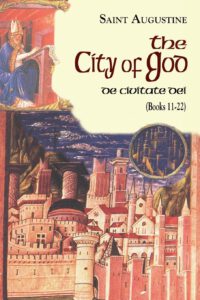
Christ’s Incarnation was a watershed event in the history of humankind. From then on, we Christians have had the opportunity to learn the true law and work toward our salvation. St Paul urges Christians to achieve this true liberation by overcoming the darkness of sin. He vividly states this to the Romans (13: 11-14): “You know what hour it is, how it is full time now for you to wake from sleep.” Then, he issues us a call to “cast off the works of darkness, and put on the armour of light […] to put on the Lord Jesus Christ, and make no provision for the flesh to gratify its desires.” This is a caution against falling head over heels for the evanescent world we live in.
How many of us respond positively to the Lord’s standing invitation? Isn’t much of what is going on in the world today an affront to the Creator? God gives His people enough rope, and some of them hang themselves! Few realise that gaining the whole world and losing one’s soul is of no use; similarly, they fail to see that life is terribly uncertain, and so is the time when the Lord will come again. The COVID-19 pandemic was no doubt an eye-opener, but the world is back to its waywardness. To quote a 19th-century advocate of the Irish Catholics, “the condition upon which God hath given liberty to man is eternal vigilance; which condition if he breaks, servitude is at once the consequence of his crime and the punishment of his guilt.”[2]

Isn’t servitude to sin rampant? How long do we wish to remain in the depths of the pit? Therefore, we must work hard to not let sin gain ascendancy in our individual and societal lives. We must not only make a collective effort toward living a life pleasing to God but also not hesitate to swim against the tide of opinion when our spiritual good so requires. Finally, we must heed St Matthew’s counsel (24: 37-44) to “be ready: for the Son of Man is coming at an hour you do not expect.” Of course, if we remain watchful, there is nothing to fear; on the contrary, eternal happiness will be the reward that we will receive.
[1] https://www.vatican.va/content/leo-xiii/en/encyclicals/documents/hf_l-xiii_enc_04081879_aeterni-patris.html
[2] John Philpot Curran (1750-1817)
The Hope of Advent
What makes Christmas the most awaited Christian celebration of the year? In our materialistic age, the gaiety that surrounds it makes it all the more attractive. However, for a heart and mind attuned to spiritual truths, Christmas is a harbinger of hope; it not only marks Christ’s birth on earth but also teaches us to await His Second Coming.
Christmas is not limited to one day. The Catholic Church celebrates Christmas from 25th December until the Solemnity of the Epiphany, which marks the manifestation of the Infant Jesus as the Saviour of the World.
How important is the preceding four-week liturgical season of Advent? If Christmas is the beginning of a spiritual journey, Advent is the preparation for its realisation. “Advent is thus a period for devout and joyful expectation.”[1]

PERIOD
“Advent begins with Evening Prayer I of the Sunday falling on or closest to 30 November and ends before Evening Prayer I of Christmas.”[2] The Sunday closest to 30 November can range between 27 November and 3 December, depending on the year. This means that Advent begins on the evening of a Saturday falling between 26 November and 2 December (inclusive), and it ends on the evening of 24 December, which holds Evening Prayer I of Christmas (25 December).
THEMES
These are indicated by a colour code, candles on a wreath, and the Liturgy (including the Word).
Colour:
The liturgical colour for Advent is violet or purple, like that of Lent, and it is a penitential season.[3]
Wreath:
“The Advent wreath, with the progressive lighting of its four candles, Sunday after Sunday, until the Solemnity of Christmas, is a recollection of the various stages of salvation history prior to Christ's coming and a symbol of the prophetic light gradually illuminating the long night prior to the rising of the Sun of justice.”[4]
Candles:
Three of the four candles are purple and used on the first, second, and fourth Sundays, to signify hope, faith, and prayer and expectation, respectively. On the third Sunday of Advent, also called Gaudete[5] (‘Rejoice’, in Latin, referring to expressed or exuberant joy) Sunday, a pink or rose candle is lit in addition to the two purple ones of the earlier Sundays. On Christmas Eve a white one is added: the ‘Christ candle’, signifying the purity of Our Lord.

Readings:
In all three liturgical cycles, the First Reading, mainly from Isaiah, includes prophecies regarding the Messiah and the messianic times.
The Second Reading, almost always from St Paul, comprises exhortations and orientations that help us be in readiness and full of hope.
The Gospel on the first Sunday refers to the Second Coming of Our Lord at the end of times; on the second and third Sundays, the focus is on the mission of St John the Baptist as the precursor of the proclaimed Saviour and preacher of a personal readiness to receive salvation; and on the fourth Sunday, the Gospel refers to the events fostering a proximate preparation for the Birth of the Saviour, with the Mother of Jesus figuring prominently therein.
The weekdays are divided into two periods: one up to 16 December, wherein the First Reading is from Isaiah and the Gospel on the life and work of St John the Baptist; the second, from 17 December to 24 December, serving to prepare more closely for the Lord’s Birth, has prophecies regarding the Messiah, from different books, for the First Reading, whereas the Gospel relates events that prepare the Nativity.[6]
Finally, the floral decoration and the music of Advent are marked by moderation, while the Gloria is neither sung nor recited.
Liturgy:
Advent Sundays (like those of Lent and Easter) take precedence over all solemnities and feasts of the Lord. Solemnities occurring on these Sundays are observed on the Saturdays preceding. No funeral Masses are celebrated either.
In the liturgy of Advent, two great figures are presented as guiding lights: John the Baptist, the precursor of Jesus, whose preaching is an invitation to conversion as an indispensable condition for salvation; and the Virgin Mary, who gave herself entirely to His holy will and waited in hope and joy for His coming into the world.
The entire liturgical season is so crucial to preparation that it is especially recommended that there be homilies even on the weekdays of Advent.
CONCLUSION
All in all, here is God’s beauty and majesty flowing through Scripture and ritual. Not the first Sunday alone, but the whole of the season of Advent is one of hope. This is a hope beyond all hopes, an eminent preparation for the Feast of Christmas. As the saying in Portuguese goes: “O melhor da festa é esperar por ela.” – The best part of the feast lies in the waiting!
[1] https://www.archbalt.org/wp-content/uploads/2017/04/GeneralNormsLiturgicalYear.pdf No. 39
[2] Ibid.
[3] According to the Code of Canon Law: “The penitential days and times in the universal Church are every Friday of the whole year and the season of Lent.” (No. 1250)
[4] Directory on Popular Piety and the Liturgy: Principles and Guidelines, No. 98
[5] The first word of the Introit of the Mass on that Sunday.
[6] Cf. ‘Synopsis of the Lectionary’, in Lectionary (Catholic Press, Ranchi, 2011), p. x.
